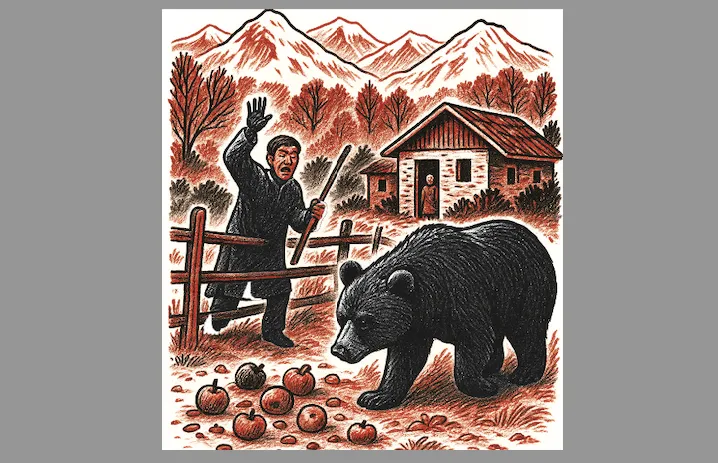Srinagar, Nov 25: At dusk in Kashmir, the night now growls back.
According to wildlife officials and experts, rotting fruit, mismanaged waste, stray dogs, lost grazing lands, and vanishing buffer zones are blurring the line between forest and village, pulling bears and other wild animals into villages.
The latest incidents occurred on Tuesday, when two black bears were trapped alive in separate operations in south Kashmir’s Anantnag district.
Officials said one of the bears, captured at Andoo Nowgam in Shangus, was the same animal that injured a woman and a man on Monday.
The second bear was caught in a trap laid at Karhpora-Soaf in Kokernag. Both animals were later released back into their natural habitats.
“We were able to successfully trap the bears in the cages set by the department,” an official of the Wildlife Department said.
The spike in sightings and attacks has left many residents anxious.
Villagers say they are terrified and avoid stepping out once darkness sets in, fearing encounters in orchards and on village paths.
Bear and leopard attacks typically rise during harvest season, and officials say this autumn has been no different.
Dozens of people have been seriously injured, and several have been killed in wildlife encounters so far in north, south, and central Kashmir.
Wildlife experts say the problem is being driven by mismanaged fruit waste, unplanned land conversion, and the disappearance of traditional buffer zones.
“Bears are often drawn by fallen or rotting fruit left on the ground. Bear attacks peak during fruit harvesting,” Wildlife Warden for the Anantnag-Kulgam range, Sajad Bhat said. “Fallen apples and food waste must be properly cleared to prevent wild animals from being attracted to orchards.”
Bhat said the mix of unharvested fruit and stray dogs has created “ideal habitats” for bears and leopards close to homes.
Head of the Department of Wildlife Sciences at Sher-e-Kashmir University of Agricultural Sciences and Technology, Kashmir (SKUAST-K), Khurshid Ahmad Shah, said many wild animals had already adapted to living near people.
“Many leopards now live and breed within urbanised populations,” Shah said. “They rely on stray dogs as prey, and apple orchards offer year-round food. The conversion of paddy fields and grazing lands has made this transition even easier.”
He said that the black bears show a similar shift.
“Except for those in Dachigam National Park, most bears have made human-dominated areas their habitat,” Shah said. “Our studies show that bears in Dachigam never come down in search of food, proving how habitat security determines animal behaviour.”
Shah said the loss of traditional buffer zones – paddy fields, maize crops, and grazing lands has erased the natural divide between people and wildlife.
“When food and shelter are easily available near villages, animals no longer need to return to forests,” he said.
The post Human-Wildlife Conflict: Rotten fruit, vanishing buffers bring bears into Kashmir villages appeared first on Greater Kashmir.
Source link



